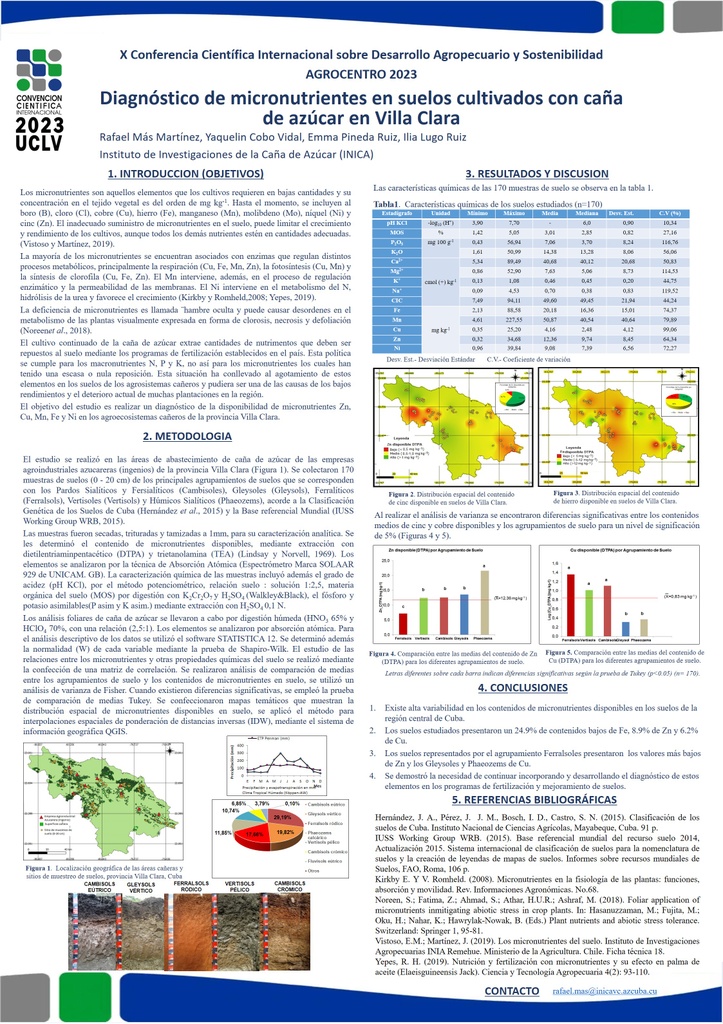Executive Secretary

9th International Scientific Conference on Agricultural Development and Sustainability
10th Symposium of Agronomy

Abstract
Problem: The continued extraction of micronutrients and their poor replacement in sugarcane agrosystems has led to the depletion of these elements in the soils and could be one of the causes of the low yields and current deterioration of many plantations in the region.
Objective(s): Determine the availability of micronutrients present in the soils dedicated to the cultivation of sugar cane in Villa Clara.
Methodology: 170 soil samples were collected and the content of available Zn, Cu, Fe, Mn and Ni was determined. Diethylenetriaminepentacetic acid was used as an extractive solution and atomic absorption spectrophotometry was used as an analytical method. The descriptive analysis of the data was carried out using STATISTICA 12. Maps were made with the spatial distribution of micronutrients in soil, using the QGIS GIS. Sugarcane foliar analyzes were carried out to complement the diagnosis.
Results and discussion: 24.9% of the soils were iron deficient; 8.9% zinc and 6.2% copper. The Ferralsols were the ones with the lowest available contents of Zn and the Gleysols and Phaeozems of Cu. The foliar analysis showed that sugarcane plantations are moderately supplied with Fe, Zn and Cu.
Conclusions: Soils present a high spatial variability in relation to the contents of available micronutrients. Iron is the most deficient micronutrient in the region, followed by zinc and copper. The need to continue incorporating and developing the diagnosis of these elements in fertilization and soil improvement programs is demonstrated.
Resumen
Problemática: La extracción continuada de micronutrientes y su escasa reposición en los agrosistemas cañeros, ha conllevado al agotamiento de estos elementos en los suelos y pudiera ser una de las causas de los bajos rendimientos y el deterioro actual de muchas plantaciones en la región.
Objetivo(s): Determinar la disponibilidad de micronutrientes que presentan los suelos dedicados al cultivo de la caña de azúcar en Villa Clara.
Metodología: Se colectaron 170 muestras de suelo y se les determinó el contenido de Zn, Cu, Fe, Mn y Ni disponibles. Se utilizó como solución extractiva el ácido dietilentriaminopentacético y la espectrofotometría de absorción atómica como método analítico. El análisis descriptivo de los datos se realizó mediante STATISTICA 12. Se confeccionaron mapas con la distribución espacial de micronutrientes en suelo, mediante el SIG QGIS. Análisis foliares de caña de azúcar se llevaron a cabo para complementar el diagnóstico.
Resultados y discusión: El 24,9% de los suelos presentaron deficiencia de hierro; 8,9% de cinc y 6,2% de cobre. Los Ferralsoles fueron los de menores contenidos disponibles de Zn y los Gleysoles y Phaeozems de Cu. El análisis foliar demostró que las plantaciones de caña de azúcar están medianamente abastecidas de Fe, Zn y Cu.
Conclusiones: Los suelos presentan una alta variabilidad espacial con relación a los contenidos de micronutrientes disponibles. El hierro es el micronutriente más deficitario en la región, seguido por el cinc y el cobre. Se demuestra la necesidad de continuar incorporando y desarrollando el diagnóstico de estos elementos en los programas de fertilización y mejoramiento de suelos.
About The Speaker

Rafael Más Martínez

Discussion

